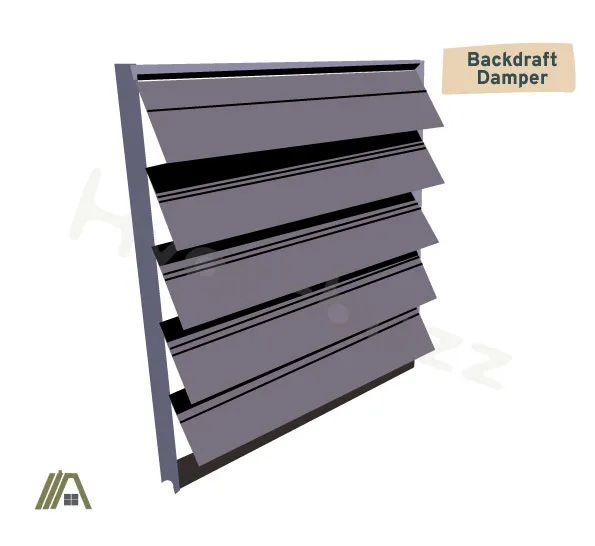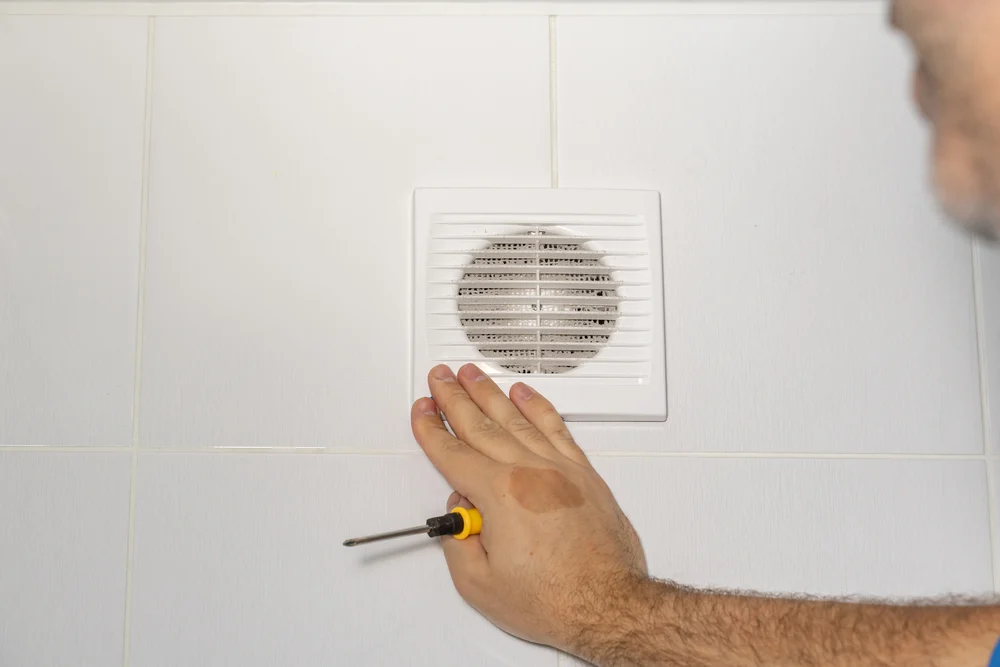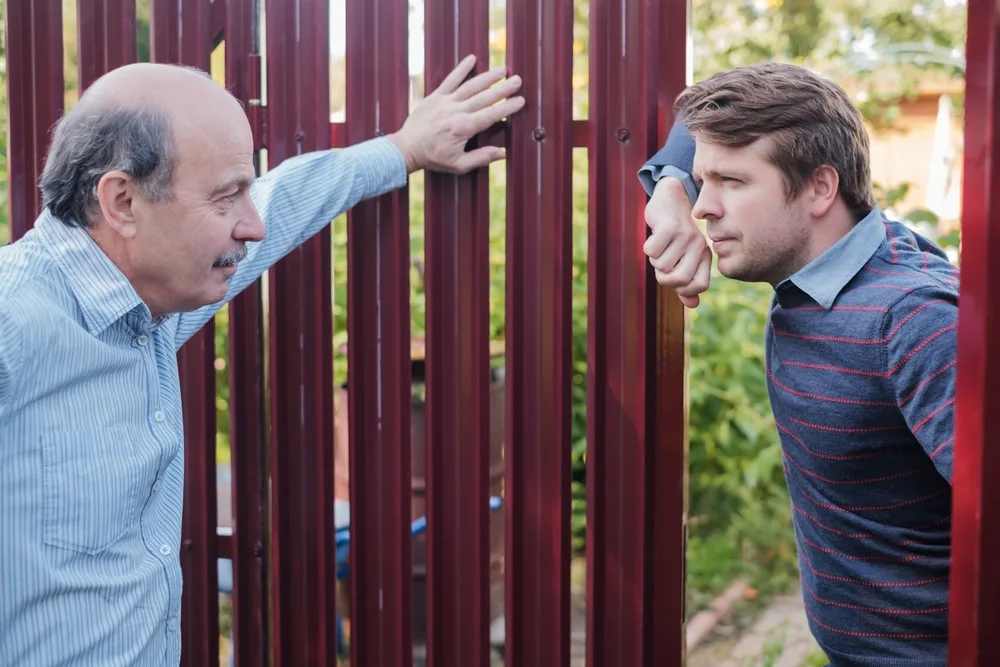Fortunately, those strange noises coming from the bathroom are not the ghosts of Christmas past. However, the noises of bathroom fans present are not a great addition to a peaceful night’s sleep either. But they are a helpful sign that your fan needs some attention, and they can even help you diagnose what might be going wrong with your bathroom fan.
I have included the most common reasons why your bathroom fan won’t be quiet and how to fix it. If you are unsure of anything, please remember to consult a professional.

Bathroom fans are noisy if backdraft dampers are damaged or fail or if animals and insects get into or onto the vent. Faulty wiring, broken humidistats, or dual-action fans can mean the fan is on when it is supposedly off. Broken vibration isolators in apartments won’t stop the noise from a neighbor’s fan.
Backdraft Damper Has Failed
If the bathroom fan is rattling like it’s on when it isn’t, I would recommend taking a look at your backdraft damper. It should be located on the roof or a nearby external wall.

Backdraft dampers are essential to bathroom exhaust fans. They are designed to allow the air to escape the bathroom and blow outside without allowing any air to enter back into the vent.
If you are experiencing a noisy bathroom fan, the reason might be that the backdraft damper has failed, i.e., it is no longer stopping outside air from blowing into the fan vent. This will result in a rattling in the fan vent and in the ductwork.
You will also probably notice some unwelcome air funneling through the vent and into your house.
The failure could be due to cracked or broken flappers (also called blades), worn mechanisms, or it might be due to a broken seal. You will need to replace or repair your backdraft damper.
Solution
Cracked and broken flappers should be replaced. You can seal a cracked blade with caulk. However, this might not be a reliable fix as it can interfere with whether the blades can sit flush.
The mechanisms of the damper can fail as they age and wear. You can hire a professional to assess the damage and advise whether a repair is viable, but buying a new backdraft damper is the safest option (and cheaper than a callout fee + a new damper).
Seals can wear and become damaged by the moisture that passes through the vent. Mold growing on the seal is also a common problem. However, this is an easy fix as you simply need to remove the old seal, clean the area, and reapply the seal. You can also opt for a mold-resistant caulk, such as the Gorilla Sealant Caulk (amazon link).
Flappers Are Getting Picked up by Wind
That clicking or tapping sound is probably your backdraft flappers being picked up and dropped by the wind, which is why your bathroom fan is noisy; the sound travels nicely through the empty metal ducts.

This can be caused by warped flappers, flappers that cannot close properly, or if your vent terminal is too exposed.
Flappers can wear and weaken over time, as is expected of a moving mechanism, and can result in warping. Dirt can easily build up in the vent and around the flappers as well.
Both problems can compromise the seal of the damper blades, resulting in an incomplete close, which wind can get under and lift the flappers.
Exposed vent terminals are more affected by winds and air pressure, especially if their flappers cannot close properly.
When it is windy, there is often a build-up of positive air pressure on one side of the vent and negative on the other. This allows the wind to force the damper open and enter the vent. This is especially problematic during strong winds, but can also happen with lighter winds if they are blowing in the right direction.
The result of an exposed terminal or uneven flappers is that strong winds are able to lift the blades of the backdraft damper, and air can get into the exhaust vent. That tapping sound results from the wind dropping the flappers as it ebbs and flows.
Solutions
Worn flappers will need to be replaced as when this mechanism of the backdraft damper is compromised, it will no longer function as required. You will likely have to replace the entire damper in order to get new blades.
If your flappers are impeded by dirt, you need to clean them and the surrounding area. This dirt can be a build of dust and gunk, but it might also be a mold build-up. Mold-resistant caulking and regularly cleaning around the damper blades can prevent the problem from occurring in the future.
If your vent terminal is too exposed, and you are having troubles, it is likely because you don’t have the right backdraft damper. Gravity backdraft dampers are opened and closed by air pressure and gravity, making them susceptible to windy weather.
You will need to exchange the damper for a spring-loaded option that relies on a spring mechanism to keep it closed and airtight. The AC Infinity Damper (amazon link) is an excellent choice for your bathroom.
You can also try getting a protective cover for your vent terminal designed to protect it from the elements.
Alternatively, you can go for the weighting solution by attaching small washers to the flappers with caulk. This will help keep them down in the wind. If they are not too heavy, the damper should still be easily able to open when the bathroom fan is on.
Animal/Insects Are in or on the Vents
If you are hearing scrabbling or buzzing inside the vent, you might find you have a houseguest, albeit an unwanted one.

Without the correct covering and a damper functioning correctly, you might get insects and small animals living in your bathroom vent. These can also take up residence on top of the vent opening.
If you don’t have a pest guard or a damper on the vent, you are vulnerable to pest troubles. If you are finding any droppings, maggots (or the like), or dander on the bathroom floor, this is a sign that something is in the vent.
It might also be a problem with your damper. Dampers are supposed to close to keep air out of the vent. This should help to keep the animals and insects out as well.
Solutions
You will first have to call in professionals to deal with the animals or insects inside the vent. Then you need a new vent cover (amazon link) to stop any other creatures from getting inside. These screens have angled slates to protect the vent opening from any intruders.
You might need a new spring-loaded damper as this will help to block entry into the vent when things can get past the guard.
You should also check for damage or holes anywhere else around the vent opening, where the pests could have entered or opened to get in.
Once you have cleared out the pests, I would also recommend checking the state inside your vent and damper since these critters can do some damage while they are in there, which can impact your bathroom fan.
Fan Is Not Actually Off
You may find yourself checking the switch, wondering why it sounds like the fan is on when it is in the “off” position. You aren’t hearing things; I would suggest you check on the wiring and model of your bathroom fan for the likely cause of why your fan keeps running.
The fan wiring can be faulty (damaged, worn, or incorrect), which can mean that your bathroom fan isn’t actually turning off when you flip the switch.
Alternatively, you may not be aware that you have a dual-action fan in your bathroom. In this case, the fan runs continuously, and the switch is used to increase the rate of extraction when the bathroom is in active use. When the fan is “turned off,” it is really switched on to the weaker, continuous flow.
If you have a humidity sensing fan, the sensor might be broken, or the settings may need adjusting. The sensor is responsible for the fan turning on and may be causing the fan to turn itself on and/or be unable to instruct the fan to switch off.
Solutions
Any wiring issue should be addressed as soon as possible as it can result in a dangerous situation, especially in a moisture-prone bathroom. Unless you are a professional yourself, I recommend having the wiring repaired and replaced by an electrician to ensure that the wiring is all up to code standard and safe.
A dual-action fan should not be creating excessive noise on its lower setting. If your fan has become noisy, you should check if the fan needs to be cleaned. I would also recommend checking when you last serviced the appliance, as that might be the problem as well.
If the noise of the continuous dual-action is unbearable, you might be able to replace it with a regular bathroom fan or a humidity sensing fan. However, you should consult an HVAC specialist before changing the fan to ensure that you will still have sufficient bathroom ventilation rates.
If you replace the broken sensor on a humidity sensing fan, you should resolve the problem with your fan constantly running. Or you can check the settings to ensure that low humidity levels are not activating the fan.
A Neighbor’s Fan Is On
What if you have already checked the wiring and the fan, and you live in an apartment building where wind cannot reach your vent and damper? Well, the noise you hear might not even be coming from your fan. Instead, you might be hearing your neighbor’s fan!

In shared residence buildings, each residence is connected to a main bathroom ventilation shaft with a backdraft damper. You may share an exhaust duct with a neighbor that goes into the central building vent, or your dampers may be nearby each other.
Either way, your fan will be able to pick up on the vibrations of their fan. This is why vibration isolators are used.
If there is something amiss with your vibration isolators, it can compromise the dampening effect. This can result in humming and buzzing coming from your fan whenever your neighbor’s fan is on.
Solutions
To solve the problem of the neighbor’s noisy fan, you will need to check your vibration isolators. They must be the correct size and density and must be installed correctly. Otherwise, you won’t get rid of the buzzing.
If any are damaged, replacing them should once more result in a peaceful silence of your bathroom fan.
Don’t forget to consult your landlord (if necessary) before you make these repairs!
Sources
https://www.nachi.org/bathroom-ventilation-ducts-fans.htm
https://www.skedaddlewildlife.com/blog/keeping-animals-out-of-home-vents/
